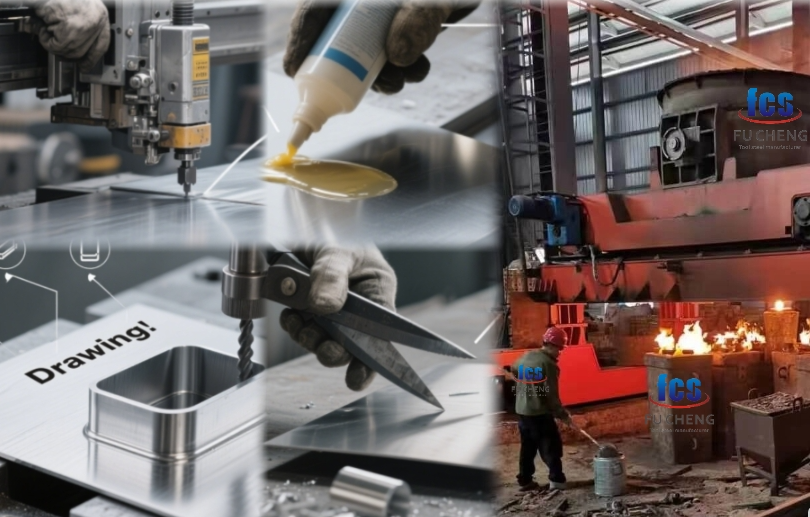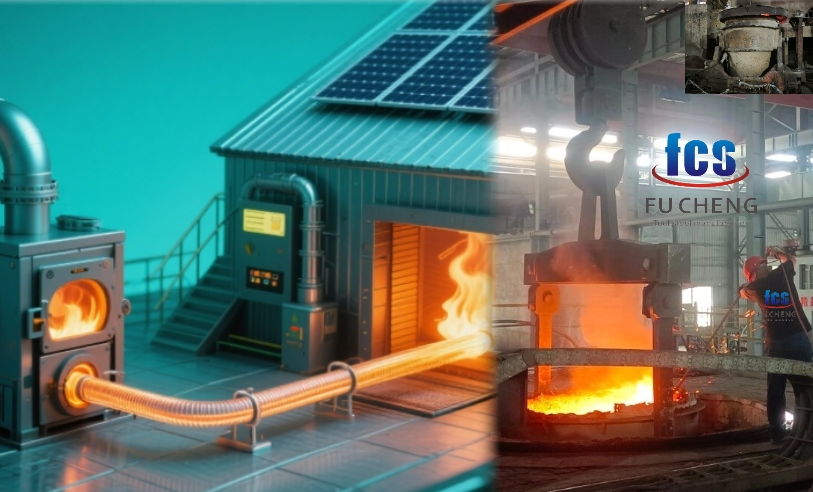We use stainless steel for many everyday items. I see it in shiny kitchen tools and strong car parts. Have you considered what it takes to shape these tough metals? Or how making them affects our environment? I believe creating stainless steel parts is quite an achievement. But, this entire process has some hidden environmental challenges. I suggest most people don’t see one simple, yet vital, part of making this industry more eco-friendly…

Overview of Stainless Steel Drawing Process

I understand stainless steel drawing as a making process. It changes flat metal sheets into smooth, 3D shapes without seams. I like that this process doesn’t use welding or joining. This makes the finished items very strong and long-lasting. I believe this process is very important for making things like car parts, kitchen items, and electronics. These industries need parts that won’t rust and work dependably.
Key Stages in the Stainless Steel Drawing Process
I suggest following these steps carefully. They help create smooth, exact stainless steel parts efficiently. These parts are great for uses where things need to be very tough and look good.
| Step | Description |
|---|---|
| Blanking | Cuts stainless steel sheets to the required precise dimensions. Accurate blanking ensures dimensional consistency and precision for subsequent manufacturing steps. |
| Lubrication | Applies specialized oils or coatings to the steel surface to reduce friction during shaping. This protects the material, extends tool/die lifespan, and enhances the final product’s surface finish. |
| Drawing | Places the blanked steel sheet over a shaped die and uses a punch to push/pull it, stretching the material into a hollow, three-dimensional form. |
| Redrawing (if needed) | Repeats the drawing process for deeper or more complex shapes. Each iteration refines the geometry to achieve the required depth, precision, or design complexity. |
| Trimming | Removes excess or uneven material from the drawn part, defining its final dimensions and creating smooth, finished edges. |
Environmental Challenges in Stainless Steel Drawing

I have seen the stainless steel drawing process damage our environment. I’ve worked in manufacturing for years. From my experience, this method takes too many of our planet’s resources. It also releases toxins into clean environments. I think it truly stops us from reaching our sustainability goals. To me, it’s like watching something beautiful come apart piece by piece. This harms the fragile environmental balance we are working hard to protect.
Carbon Emissions and Energy Consumption
Producing stainless steel, including the drawing part, releases 0.20 to 0.50 tonnes of CO₂ for every tonne of steel made. Most companies produce emissions in this range. I think this adds a lot to worldwide greenhouse gas emissions and climate change. This work also uses a great deal of energy. This energy use increases its carbon footprint.
Waste and Pollutant Release
Drawing processes can release small particles, oils, and wastewater. This water often has metals and chemicals from the process. From my experience, these releases need good treatment. This treatment stops harm to the environment. I believe managing water and air pollution is very important. It helps lessen the harm to local nature and people’s health.
Resource and Raw Material Consumption
Making stainless steel uses a lot of resources. It needs large quantities of water, raw materials, and energy. Stainless steel lasts a long time. It is also valuable when it’s no longer needed. This means we replace it less often. However, I note that the first steps to make it still use up many natural resources.
Ecosystem and Human Health Impacts
Studies on the product’s full life cycle show something important. The molten iron stage is a key part of making stainless steel. I understand this stage causes the most harm to human health. This is because it uses so many resources and so much energy. The main dangers from this industry, in my opinion, affect people’s health, our climate, the quality of nature, and use up our resources.
Waste Management and Recycling
Even though it uses many resources, stainless steel is very recyclable. About 95% of stainless steel gets recycled after its useful life. Most new stainless steel items have over 50% recycled material in them. I like that this creates a cycle. It means less waste. It also means we need fewer new raw materials.
Industry Environmental Management Practices
To handle these problems, I see companies are doing several things:They are adding environmental protection into their company plans.They are handling raw materials, waste, and byproducts by following rules.They are putting pollution prevention, saving resources, and recycling first.I recommend they continue investing in cleaner methods and new research.
In my view, the stainless steel drawing process needs to fix issues with CO₂ emissions, using up resources, releasing pollution, and managing waste. I am encouraged that the industry is using tougher environmental rules and recycling more. These actions will help solve these environmental issues and support a shift to greener methods.
Green Transition Paths and Practices

Based on my years in this field, I’ve seen we can change stainless steel production. I am convinced we need new, sustainable ideas to improve how stainless steel is drawn. I suggest we adopt smart methods. These methods will sharply cut emissions and also help protect our natural resources. For me, it’s like carefully tending a garden to bring it back to full health. From what I’ve seen working with manufacturers, these changes do more than help the environment. They improve the whole production system. This helps build a good connection between industry and our planet.
Renewable Energy Adoption in Stainless Steel Production
I see the industry taking big steps to use more renewable energy. My suggestion is to bring solar, wind, and green hydrogen into production. This helps make steps needing very high temperatures (above 1,500°C) less carbon-heavy. This means less dependence on fossil fuels. I believe this greatly cuts the process’s carbon footprint.
Electric Arc Furnace (EAF) Technology for Emissions Reduction
I notice stainless steel makers are using Electric Arc Furnaces (EAF) for melting. I think EAFs are great because they use less energy than old blast furnaces. EAFs use scrap steel as the main material. This cuts emissions. We recycle steel instead of using new iron ore. Based on what I’ve seen, this method has cut average melt shop emissions quite a bit.
Raw Material Selection and Scrap Utilization
I think choosing raw materials with a smaller carbon footprint is a top goal. The quantity of recycled scrap melted matters a lot. It’s also important if the energy used for melting is clean. These factors greatly influence the environmental impact. I find it impressive that leading plants now use up to 90% recycled material for laser welding. About 80% of this material comes from post-consumer items.
Three R’s Principle: Recycle, Reduce, Reuse
| Three R’s Principle | Description |
|---|---|
| Recycle | Stainless steel production increasingly relies on recycled materials, with nearly all modern stainless steel incorporating a high proportion of reclaimed steel to reduce reliance on raw material extraction and minimize environmental impact. |
| Reduce | Focus on lowering CO₂ emissions across all manufacturing stages, with particular emphasis on optimizing the drawing process to achieve energy efficiency and sustainable production practices. |
| Reuse | Design stainless steel products for durability and reusability, ensuring they can be repurposed or recycled at the end of their lifecycle to eliminate waste and decrease the need for new material consumption. |
Immediate Actions for Decarbonization
To make faster progress in cutting carbon, I recommend companies: Change their suppliers and how they buy things. They should choose greener materials. Make their work processes more efficient. This helps avoid waste and stops things from being done poorly. Update to new, proven technologies that create less carbon.
Green Product and Application Design
In my experience, product development now really stresses:Making components that last a long time and are easy to recycle. Using stronger types of stainless steel. This helps use less material overall. Designing applications that are purely for low emissions and simpler recycling at the end of their life. I believe this is a very practical approach.
Long-term Green Transition Targets
Looking ahead, I think the steel industry‘s main aims are: 1. Developing stainless steel uses that have a long life. These uses should always have a low impact on carbon. 2. Making products that are 100% recyclable. These products should also come from recycled sources. 3. Offering solutions that genuinely help larger efforts to reduce carbon and achieve climate goals.I observe these changes are now very important. People worldwide want more stainless steel, and the quality standards are increasing. From my perspective, manufacturers must commit to these green changes. It’s quickly becoming necessary for their survival.
summary
From my experience with the stainless steel industry, I’ve learned something important. I believe we must balance making products with protecting our environment. I think this is more than a good idea; it’s absolutely necessary. I notice people care more about eco-friendly products these days. Based on this, I believe companies that use green practices will be the most successful. I feel they will lead the market. I see that making stainless steel in a sustainable way is a big change. In my view, this greatly benefits our planet. I also think it makes businesses stronger and more efficient. When we support these changes with our own choices, I think we all help. We can build a cleaner future. I imagine a future where industry and nature can flourish side by side.
